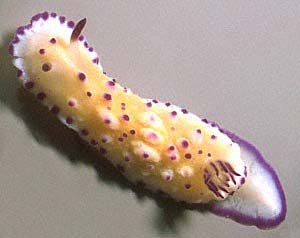
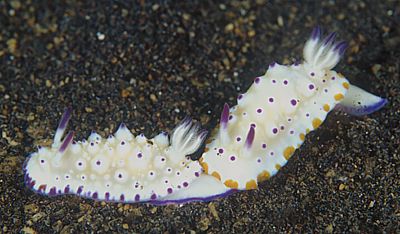
Mexichromis multituberculata
(Baba, 1953)
Order: NUDIBRANCHIA
Suborder: DORIDINA
Family: Chromodorididae
DISTRIBUTION
Known only from Seto, Kii, Japan and Hainan Is. and Hong Kong in southern China.
PHOTO
UPPER: Trio Is (E), Hong Kong, China, July 1989. Photo: B.W. Darvell.
LOWER: Bali, Indonesia, Oct 2001. Showing colour variation. Found together in 10m. Lengths 30mm. Photo: Stuart Hutchison.
Originally described from Japan and later recorded from southern China, Mexichromis multituberculata was considered to differ from the other western Pacific species of Mexichromis, Mexichromis festiva, Mexichromis macropus and Mexichromis mariei in having purple spots around the edge of the mantle rather than yellow or orange. The mantle has scattered purple-tipped tubercules. However Stuart Hutchison's message suggests that Mexichromis multituberculata almost certainly includes animals with reddish, purple, blue or orange spots around the mantle edge.
Note added 20 December 2002: Animals with spots around the mantle edge, other than blue, have been moved here from the Mexichromis cf. multituberculata page.
References:
• Baba, K. (1953). Three new species and two new records of the genus Glossodoris from Japan. Publications of the Seto Marine Biological Laboratory, 3: 205-211.
• Rudman, W.B., Darvell, B.W. (1990) Opisthobranch Molluscs of Hong Kong: Part 1. Nudibranch Families; Goniodorididae, Onchidorididae, Triophidae, Gymnodorididae, Chromodorididae. Asian Marine Biology, 7: 31-79.
Rudman, W.B., 1999 (January 16) Mexichromis multituberculata (Baba, 1953). [In] Sea Slug Forum. Australian Museum, Sydney. Available from http://www.seaslugforum.net/find/meximult
Related messages
Mexichromis multituberculata from Lembeh
November 23, 2009
From: Zeineb Alhaidari


Dear Bill ,
I see in your answer to message #22085 that you are interested in variability of local populations of Mexichromis multituberculata. Here are some samples from Lembeh .The first one was observed on the dive site Aer bajo , the second on the dive site Nudi retreat at about 20 metres depth on the 5 th of october 2009, and the third one on the dive site Aer Prang at about 10 metres depth on the 10 th of october.
Locality: Lembeh Strait, North Sulawesi, Indonesia, Molucca sea. Upper Photo: Aer Bajo, 25 meters, 04 October 2009, Sand and sediment. Length: approx 4 cm. Middle Photo: Nudi retreat, 20 metres depth, 5 October 2009. Lower Photo: Aer Prang, 10 metres, 10 October 2009. Photographer: Zeineb Alhaidari.
Best regards,
Zeineb
z.alhaidari@wanadoo.fr
Alhaidari , Z., 2009 (Nov 23) Mexichromis multituberculata from Lembeh. [Message in] Sea Slug Forum. Australian Museum, Sydney. Available from http://www.seaslugforum.net/find/22835
Dear Zeineb,
Thanks for these photos. They help to illustrate the difficulties in distinguishing species of this genus as the pair in your second photo are almost certainly what I would call Mexichromis mariei. The tubercles in that species are more rounded and spaced than in M. multituberculata.
Clearly this genus needs some more work
Best wishes,
Bill Rudman
Re: Mexichromis multituberculata
November 19, 2009
From: Valda Fraser
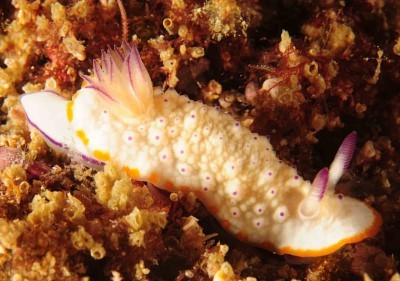
Dear Bill
I think this may be Mexichromis multituberculata. Would be grateful if you could confirm.
Locality: Pomene, 28 m, Mozambique, Indian Ocean, 14 November 2009, Scattered reef. Length: 30 mm. Photographer: Valda Fraser.
A big thank you.
Valda
valdafraser@mweb.co.za
Fraser, V.J., 2009 (Nov 19) Re: Mexichromis multituberculata. [Message in] Sea Slug Forum. Australian Museum, Sydney. Available from http://www.seaslugforum.net/find/22816Dear Valda,
Yes I would call this M. multituberculata. The orange mantle border is more complete than we usually see but I assume it's just part of the variability. This is the furthest south in the Indian Ocean I think it has been found, but since we have records from Reunion Id I guess it was only a matter of time.
Best wishes,
Bill Rudman
Mexichromis multituberculata? from Oman?
December 11, 2008
From: Darja Tjioe

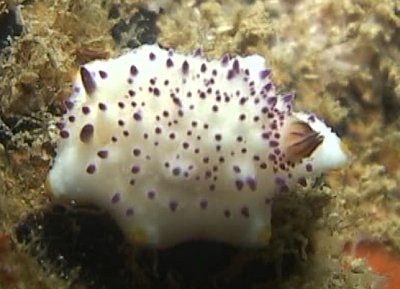
Hi Bill,
After going through the whole species list at least twice I am getting more and more desperate to identify this very common species in Oman. Well, at least, I keep bumping into them ...
Have I overlooked something or is it Cadlinella?
Locality: Al Munassir wreck near Muscat, 16 to 25 meters, Oman, Arabian sea, 27 November 2008, Wreck. Length: 5 centimeters. Photographer: Darja Tjioe.
Thanks for your help,
Darja
tjioeke@hotmail.com
Tjioe, D., 2008 (Dec 11) Mexichromis multituberculata? from Oman?. [Message in] Sea Slug Forum. Australian Museum, Sydney. Available from http://www.seaslugforum.net/find/22085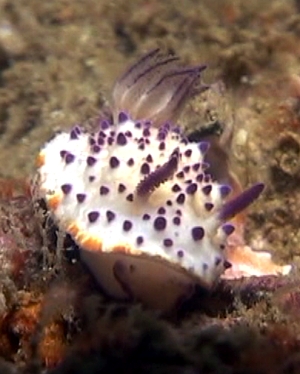
Dear Darja,
The pointed tubercles on the mantle are similar to those of some Cadlinella, but this is a species of Mexichromis, and almost certainly the one we are calling Mexichromis multituberculata. However the more photos I see of this 'species' the more I wonder whether there is one variable species ranging in colour from purple to reddish spots and ranging in the degree the spots became raised into rounded tubercles and even pointed tubercles. When I first tried to identify a specimen of this purple spotted form [from India - Rudman, 1973] I concluded it was a form of C. mariei (Crosse, 1872) first described from New Caledonia. Until recently I have been happy to accept Baba's name M. multituberculata for animals with large pointed tubercles on the mantle, but the variability shown in photos on the Forum which I have variously identified as M. mariei, M. cf. mariei. M. multituberculata and M. cf. multituberculata make me wonder if they are all variations of one species. Even M. festiva and M. macropus are very similar [see Rudman, 1983].
If this form with pointed tubercles is considered distinct the Chromodoris sannio Bergh, 1890 is a much earlier name. It was described from Indonesia and the purple spots were described as being raised on vesicles. Charles Eliot (1905) reported similar animals from Muscat 100 years ago and identified them as C. sannio. So what should you call your animals? I would suggest you use Mexichromis multituberculata, but I suspect when this group is sorted out we will use M. mariei for them all, or perhaps M. sannio for the pointed ones.
If this species is quite common in your area, it would be worthwhile keeping a lookout for variability in colour and whether the spots vary from rounded tubercles to pointed papillae. If we are dealing with a variable species it would be nice to get some evidence of it in local populations.
- Bergh, L. S. R. (1890) Die Nudibranchien des "Sunda-Meeres". Malacologische Untersuchungen. In: C.G. Semper, Reisen im Archipel der Philippinen, Wissenschaftliche Resultate., 17, 873-992,Pls.885-889.
- Crosse, J. C. H. (1872) Description d'un genre nouveau et d'espèces inédite, provenant de la Nouvelle-Calédonie. Journal de Conchyliologie, 20, 148-154.
- Eliot, C. N. E. (1905) Nudibranchs from the Indo-Pacific. 1. Notes on a collection dredged near Karachi and Maskat. Journal of Conchology, 11, 237-256.
- Rudman, W. B. (1973) Chromodorid opisthobranch Mollusca from the Indo-West Pacific. Zoological Journal of the Linnean Society, 52, 175-199,177figs,172col.pl.
- Rudman, W. B. (1983) The Chromodorididae (Opisthobranchia: Mollusca) of the Indo-West Pacific: Chromodoris splendida, C. aspersa and Hypselodoris placida colour groups. Zoological Journal of the Linnean Society, 78, 105-173.
Best wishes,
Bill Rudman
Three species feeding on the same sponge in Bali
August 9, 2007
From: Mike Krampf

I know you don't like a message that has multiple species but thought you might find this one interesting as all three species appear to be feeding. I have identified them as Mexichromis multituberculata [upper right in top photo], Hypselodoris kanga [lower right], Pectenodoris trilineata [upper left].
Locality: Seraya Bay, 40 ft, Tulamben Area, Bali, Indonesia, Java Sea, 27 July 2007, Black sandy area with scattered small coral patches. Length: 1 cm to 4 cm. Photographer: Mike Krampf.
Cheers,
Mike
mtkrampf@yahoo.com



Dear Mike,
This is the very exception to the one species per message rule which I welcome - the mixture of species is the topic. I am not sure what the red stuff is all through the background of your photo but I suspect it is a cnidarian [sea anemone or soft coral]. The sponge they are all eating - or at least associated with - is a blue species of Dysidea. We have records of all three species feeding on this blue Dysidea but this is a nice illustration of my hypothesis that food is probably a, if not the, major cause of these inter- and intra- species aggregations.
Best wishes,
Bill Rudman
Re: Feeding in Mexichromis multituberculata
July 17, 2007
From: Richard Swann
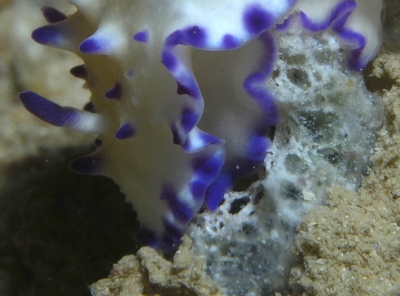
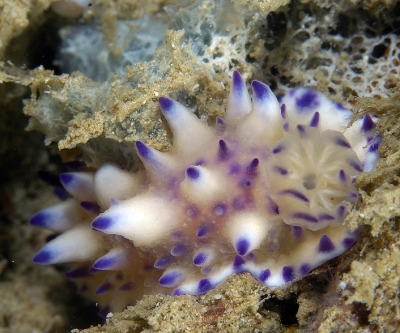
Concerning message #14106:
Hi Bill
I have a few shots of Mexichromis multituberculata feeding and thought I would post them. I know you have a couple of posts already with what looks to me like the same sponge Euryspongia but its always good to get another one.
There are two different shots with one close up they were taken a few days apart in the same location.
Locality: Mamutik island,Kota Kinabalu, 12m , Sabah, Borneo, South China Sea, 11th and 15th May 2007, Reef slope, . Length: 15-20mm. Photographer: Richard Swann.
Hope you find them of interest.
Best regards
Richard
www.downbelow.co.uk
richard@downbelow.co.uk
Swann, R., 2007 (Jul 17) Re: Feeding in Mexichromis multituberculata. [Message in] Sea Slug Forum. Australian Museum, Sydney. Available from http://www.seaslugforum.net/find/20194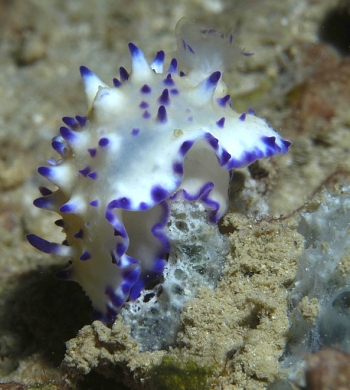
Dear Richard,
Yes this is Euryspongia. At this stage, our understanding of feeding specialisation in these animals is in its infancy, so all new records are welcome. This is one of those sponges which can apparently withstand a layer of silt over much of the colony - at least for short periods. I suspect all the brownish background in your photos are part of the sponge colony.
Best wishes,
Bill Rudman
Tiny nudibranch near rhinopore of Mexichromis
July 17, 2007
From: Ken Tucker
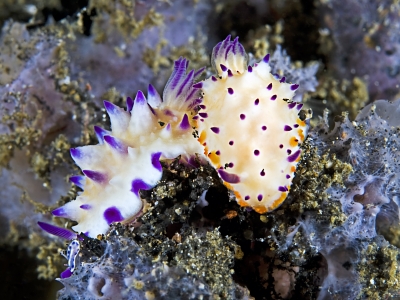
While photographing the two larger Mexichromis multituberculata, a tiny nudibranch came into view near one of the rhinopores. Because of its size, about 3 mm, I didn't notice it until I edited this photo. I'm a but confused by some of the reference photos I've seen for Mexichromis, but imagine these are both M. multituberculata. I'd like clarification.
As for the smaller nudibranch, I've not been able to find a match. Can someone id?
Locality: Lembeh Strait, site is Hairball, 12 metres, North Sulawesi, Indonesia, Celebes Sea, 5 Nov 2005, near shoreline. Length: two larger specimens appro 3 cm, smaller approx 3 mm. Photographer: Ken Tucker.
Ken Tucker
ken@kilili.com


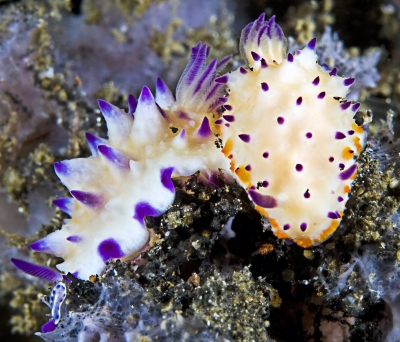
Dear Ken,
Firstly I see you would like clarification on the identification of Mexichromis multituberculata - wouldn't we all! I foolishly thought I had them sorted out many years ago (Rudman, 1973, 1983, 1984) but as more material comes available, colour and shape of the tubercles seems to become less important in this group of species. It is a very instructive lesson in showing that we have much to learn. Many colour picture books / identification guides tend to give the impression we know it all but that is far from so. All I can say at present is that your animals seem to be part of the colour variability of M. multituberculata - but its possible there is an earlier name available.
You didn't mention the sponge you animals are on. This is a species of Euryspongia, which seems to be the food choice of this species. From the yellow spots on the dorsum and the red on the gills, I suspect the little juvenile is Hypselodoris infucata. It is normally found feeding on dysideid sponges, so it wouldn't be out of place on Euryspongia.
-
Rudman, W.B. (1973) Chromodorid opisthobranch Mollusca from the Indo-West Pacific. Zoological Journal of the Linnean Society, 52(3): 175-199, 7 figs, 2 col. pl.
-
Rudman, W.B. (1983) The Chromodorididae (Opisthobranchia: Mollusca) of the Indo-West Pacific: Chromodoris splendida, C. aspersa and Hypselodoris placida colour groups. Zoological Journal of the Linnean Society, 78: 105-173.
-
Rudman, W.B. (1984) The Chromodorididae (Opisthobranchia: Mollusca) of the Indo-West Pacific: a review of the genera. Zoological Journal of the Linnean Society, 81: 115-273.
Best wishes,
Bill Rudman
Mexichromis multituberculata from NE Sulawesi
November 28, 2006
From: Jim Anderson
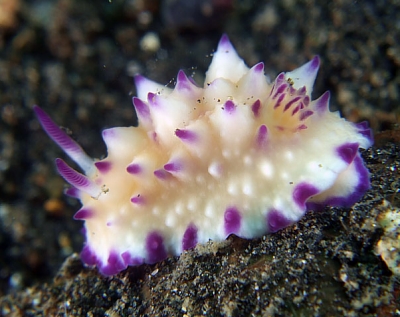
Concerning message #16122:
Dear Bill,
The attached is Mexichromis multituberculata I think, found during a recent dive in Lembeh Strait.
Locality: Tikey 2, Lembeh Strait, 12 m, N E Sulawesi, Indonesia, Celebes Sea, 4 July 2006, dark volcanic sand. Length: 25 mm. Photographer: Jim Anderson.
Regards,
Jim A
jander4454@gmail.com
Anderson, J., 2006 (Nov 28) Mexichromis multituberculata from NE Sulawesi. [Message in] Sea Slug Forum. Australian Museum, Sydney. Available from http://www.seaslugforum.net/find/18593Thanks Jim,
This is a good example of what I would call the 'typical' colour form of this species. As I discussed in Philibert's recent message [#18462], there seems to be considerable colour variation in this species
Bill Rudman
Mexichromis multituberculata or M. katalexis?
November 24, 2006
From: Philibert Bidgrain
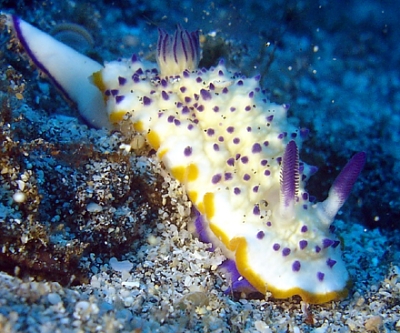
Concerning message #14457:
Last week, we found this wonderful seaslug for the first time in Our Island. I think it's a Mexichromis sp, but I have some hesitation about the species. You have in the forum a species called Mexichromis cf. mariei found in South Africa but the tubercule structure is really different. This specimen looks like a little M. multituberculata but more like another species described by Yonow from Ambon as M. katalexis.
Locality: Saint Gilles, 25 m, Reunion Island, Indian Ocean, November 2005. Length: 20 mm. Photographer: Philippe Cao Van.
What's your opinion for this marvellous seaslug ?
Philibert Bidgrain
http://vieoceane.free.fr/runseaslug/indexslug.htm
pbidgrain@yahoo.fr
Bidgrain, P., 2006 (Nov 24) Mexichromis multituberculata or M. katalexis?. [Message in] Sea Slug Forum. Australian Museum, Sydney. Available from http://www.seaslugforum.net/find/18462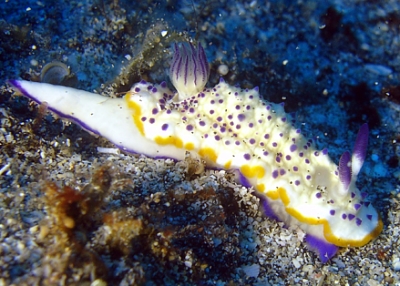
Dear Philibert,
As you will see in earlier messages [#8655], my feeling is that Mexichromis multituberculata encompasses colour forms with orange and wine red mantle borders as well as the typical blue border. Nathalie Yonow's Mexichromis katalexis, with orange spots around the mantle border and wine red-tipped tubercles would seem to be part of the colour variation within this species. Yonow (2001) considers there are radular differences - the first two laterals are not as flattened as the other laterals - but she only had glass slide mounts of the radula so such differences could be as much to do with the thickness of the mounting medium as any real morphological difference.
We now have a lot of photos on the Forum showing colour variability in this group of the genus. I don't think there is much to be gained in pulling out one colour form and giving it a new species name. Your animal shows the problems in thinking that way. If we accept M. katalexis with red tipped tubercles and orange-yellow patches around the mantle border, we would have to make a new species for your animal with blue-tipped tubercles and an almost continuous yellow line around the edge of the border, and another for the form with red tips and red border etc, etc.
- Yonow, N. (2001) Results of the Rumphius Biohistorical Expedition to Ambon (1990). Part 11. Doridacea of the families Chromodorididae and Hexabranchidae (Mollusca, Gastropoda, Opisthobranchia, Nudibranchia), including additional Moluccan material. Zoologische Mededelingen uitgegeven Rijks Museum van Natuurlijke Historie te Leiden 75: 1-50.
Best wishes,
Bill Rudman
Mexichromis multituberculata from Thailand
April 3, 2006
From: Lawrence Neal
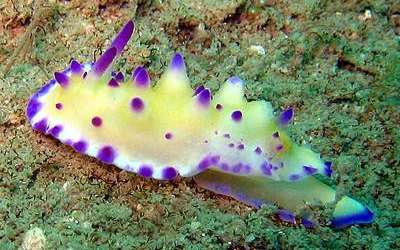
This nudibranch was found crawling on a sediment/sand bottom in about 10 meters near Pattaya, Thailand. It was about 1 inch long. Can't seem to find it in the books I have. Can you identify it?
Locality: Koh Sark, Pattaya, 10 metres, Thailand, Gulf of Thailand, 04 March 2006, Sandy/Sediment bottom. Length: 1 inch. Photographer: Lawrence Neal.
Thanks,
Lawrence Neal
lorenzo_n@yahoo.com
Neal, L., 2006 (Apr 3) Mexichromis multituberculata from Thailand. [Message in] Sea Slug Forum. Australian Museum, Sydney. Available from http://www.seaslugforum.net/find/16122Dear Lawrence,
This is Mexichromis multituberculata.
Best wishes,
Bill Rudman
Mexichromis multituberculata from Egypt
August 3, 2005
From: Martina Balzarova
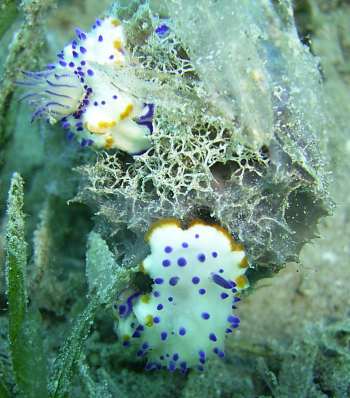
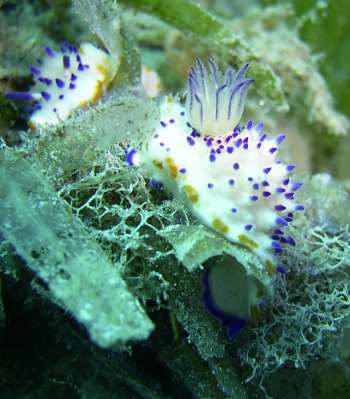
Hi,
Can you help me? I have some pictures of slugs. It´s from Red sea. I think that it is Mexichromis multituberculata or Mexichromis mariei. What do you think?
Martina
Locality: grass bottom near coast, Dahab, Egypt, Red Sea. Depth: 15 m. Length: 5 cm. 10 August 2004 Photographer: Martina Balzarova
Martina Balzarova
seamaster@vol.cz
Balzarova, M., 2005 (Aug 3) Mexichromis multituberculata from Egypt. [Message in] Sea Slug Forum. Australian Museum, Sydney. Available from http://www.seaslugforum.net/find/14452
Dear Martina,
From the very large tubercles this can only be Mexichromis multituberculata, which makes your find a very large range extension from the Western Pacific.
One thing of special interest is that your photos could have been part of the same series of photos in Jun Imamoto's message [#14106 ] from Japan. In both cases, the animals are feeding on the same sponge, which Dr P.R. Bergquist has identified as a species of Euryspongia [F. Dysideidae]. This is a very valuable addition to our knowledge of the biology of this species.
Best wishes,
Bill Rudman
Feeding in Mexichromis multituberculata
June 24, 2005
From: Jun Imamoto

Dear Bill,
Here is a picture I took of Mexichromis multituberculata feeding.
Locality: Amami-Ooshima Islands, Kagoshima, Japan. The East China Sea
Depth: 8 m. Length: 14 mm. 18 June 2005. On dead coral. Photographer: Jun Imamoto
Best Regards,
Jun Imamoto
http://www.umiushi.info/
imamoto@umiushi.info
Imamoto, J., 2005 (Jun 24) Feeding in Mexichromis multituberculata. [Message in] Sea Slug Forum. Australian Museum, Sydney. Available from http://www.seaslugforum.net/find/14106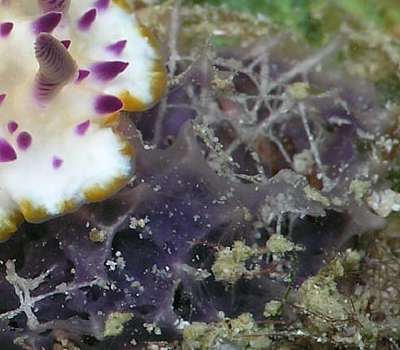
Thanks Jun,
We have very little information concerning any species of Mexichromis feeding, so this is a valuable addition.
Best wishes,
Bill Rudman
Mexichromis multituberculata from Sulawesi
December 23, 2002
From: Mary Jane Adams
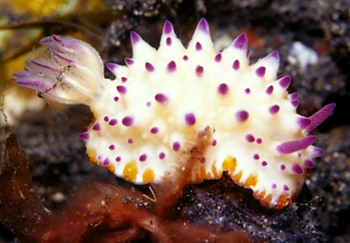
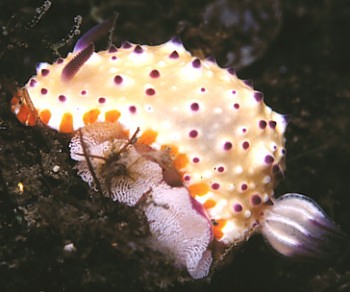
Hi Bill,
Here are two Mexichromis multituberculata from Lembeh Strait, Sulawesi Island, Indonesia for your database. Both have purple-tipped turbercles and orange spotted mantle borders. The upper image is from divesite Hairball Too. The furry thing in the foreground is an algae-decorated "gorilla" crab. Neither animal was moving so I photographed them as I found them on Nov. 24. 2002. The other image of the slug laying eggs (110216) is from divesite JAHIR. I photographed it on Nov. 21, 2002. Both slugs were about 25mm long and found at 8-15 meters on mucky volcanic sand slopes.
Best regards,
Mary Jane
divepng@yahoo.com
Adams, MJ., 2002 (Dec 23) Mexichromis multituberculata from Sulawesi. [Message in] Sea Slug Forum. Australian Museum, Sydney. Available from http://www.seaslugforum.net/find/8655Thanks Mary Jane,
I see that in Stuart Hutchison's message I had decided that Mexichromis multituberculata almost certainly included animals with red, purple, blue or orange spots around the mantle edge. So I have finally plucked up the courage to amalgamate the animals on the Mexichromis cf. multituberculata with those on the Mexichromis multituberculata Page.
Best wishes,
Bill Rudman
Mexichromis multituberculata from Bali
February 24, 2002
From: Stuart Hutchison

Bill,
Here are some shots of Mexichromis multituberculata from Bali, Indonesia in Oct 2001.
• The pair [upper right] were found in 10m and have different mantle colourations. Lengths 30mm.
• The trio [lower left] were found together at around 20m, one minding an eggmass and the further animal in the process of laying. They were all the same colour. Lengths from 20-30mm.
• The solo animal [lower right] was found at 10m and was about 30mm long.
Stuart
stuart@stuarthutchison.com.au

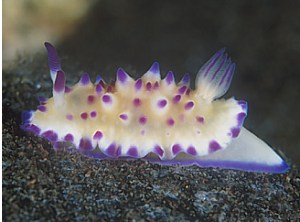
Thanks Stuart,
I think we are only on step away from demonstrating that Mexichromis multituberculata can have either blue or orange spots around the mantle edge. And if we include Mike Miller's earlier photos, we can include a wine-red colour in the variation as well.
What would be nice is a photo of a blue-spotted form mating with an orange-spotted animal. I am just about to go off for a week's fieldwork but when I return I think I will either combine these animals with the M. multituberculata Page or at least make a strong suggestion on that page that they are probably all the same species.
Best wishes,
Bill Rudman
Hong Kong Mexichromis multituberculata
February 2, 2002
From: W.B. Rudman & B.W. Darvell
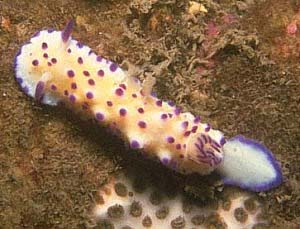
Here is some information and photos on Mexichromis multituberculata from Brian Darvell's Hong Kong collections.
The large rounded purple-tipped tubercles scattered all over the mantle clearly characterize this species. The yellowish mantle fades to white near the edge which has an irregular purple border anteriorly and a series of purple spots down each side. The rhinophores are purple and upper half of gills lined with purple. Foot bordered with same colour. Grows to 20 mm long (Baba 1953)
PHOTO:
12 m on Breaker Reef, Mirs Bay, Hong Kong, 1987. (no specimen collected). Photo: Brian Darvell.
Hong Kong Collection Records:
(1) AM C159191, Trio Is (E), 5m, Hong Kong, 9 July 1989. (2) 12 m on Breaker Reef, Mirs Bay, 1987, no specimen being collected
Reference:
• Rudman, W.B. & Darvell, B.W. (1990) Opisthobranch molluscs of Hong Kong. Part 1. Goniodorididae, Onchidorididae, Triophidae, Gymnodorididae, Chromodorididae, (Nudibranchia). Asian Marine Biology, 7: 31-79
Best wishes,
Bill Rudman & Brian Darvell
Mexichromis from Bali, Indonesia
December 24, 2001
From: Mika Oyry
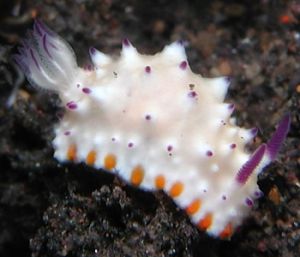
Hello,
I found this nudibranch at Bali, Tulamben, Indonesia. It was night dive and he was under the stone.
Size is around one centimeter, so I thought that it's not adult yet. I have not found it from the books, so I would like to know what species this one is.
Mika
mika.oyry@nokia.com
Oyry, M., 2001 (Dec 24) Mexichromis from Bali, Indonesia. [Message in] Sea Slug Forum. Australian Museum, Sydney. Available from http://www.seaslugforum.net/find/5865Dear Mika,
This is a species of Mexichromis. At present it is not quite clear how many species there are and just how much variation there is in colour and pointed tubercles within each species. So at the moment, until more reserach is completed on the group, I am calling animals that look like yours Mexichromis cf. mutituberculata. The 'cf' just means that it looks quite like Mexichromis multituberculata but is probably something else.
If you look at the top of this page you will find links to other similar species of Mexichromis
Best wishes,
Bill Rudman
Mexichromis cf. multituberculata with egg mass
November 24, 2001
From: Michael D. Miller
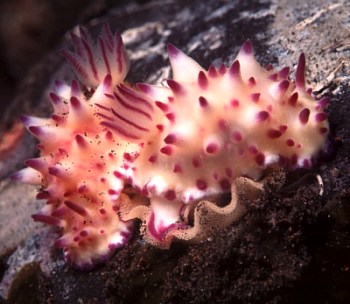
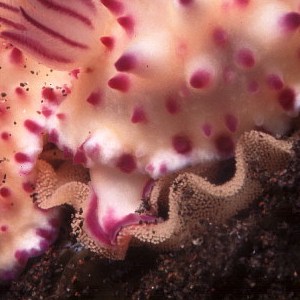
Dear Bill
In response to your request for more pics with egg masses, you will find
attached an image of Mexichromis cf. multituberculata with egg mass.
Location: Tulamben, Bali, Indonesia
Depth: 20 ft.
Date: Oct. 2001
Photographer: Michael Miller
Cheers;
Michael Miller
mdmiller@cts.com
Miller, M.D., 2001 (Nov 24) Mexichromis cf. multituberculata with egg mass. [Message in] Sea Slug Forum. Australian Museum, Sydney. Available from http://www.seaslugforum.net/find/5720Thanks Mike,
This looks very interesting. Although its hard to be sure, the eggs look quite big - and as you can see in my photo they are at least as big as the eggs of Mexichromis festiva, which is a direct developer. Your animal's eggs are also the same colour, but the wavy edge is different. It would certainly be good to see some egg masses from the other species of Mexichromis.
Best wishes,
Bill Rudman
Mexichromis from Papua New Guinea
August 18, 2000
From: Mary Jane Adams


Hi Bill,
Can you tell which species of Mexichromis these are? I found them on a silty sand slope near Bunama Mission, Normanby Island, Papua New Guinea in March 1999.
Depth = 23 meters
Length = about 22 mm
(Note missing rhinophore in bottom photo)
Thanks!
Mary Jane
mjadams@earthlink.net
Adams. M.J., 2000 (Aug 18) Mexichromis from Papua New Guinea. [Message in] Sea Slug Forum. Australian Museum, Sydney. Available from http://www.seaslugforum.net/find/2838Dear Mary Jane,
I am afraid there is no simple answer at present. If you read some of my comments on the Mexichromis pages you will see that my 'simple solution' has been scuttled by an embarassment of specimens. I am just arranging photos in 'look alike' groups until I can rework the material I have in hand.
So I have put your animals on the Mexichromis cf. multituberculata page, but at present the limits are blurred and it seems that the degree of tuberculation may not be a useful species character, more than one species may in fact have a range from low rounded tubercles to quite elongate pointed papillae.
Best wishes,
Bill Rudman.
Mexichromis multituberculata? from Bali
January 16, 1999
From: Michael Miller

Dear Bill,
Am attaching group photo of Mexichromis multituberculata exhibiting color
variation in specimens photograped at Tulamben, Bali, Indonesia.
Cheers;
Michael Miller
mdmiller@cts.com


Dear Michael,
Your picture is very interesting. I have looked at specimens from eastern Australia and New Caledonia which are identical to the animal with the orange-spotted border, but I have never seen the form with the wine-red spots which is clearly conspecific. I have had difficulty making sense of the complex in the southwest Pacific but your find may be very useful. One possibility is that this "species" may in fact be a distinct species mimicking M. multituberculata in the north and M. mariei in the south.
Bill Rudman.
